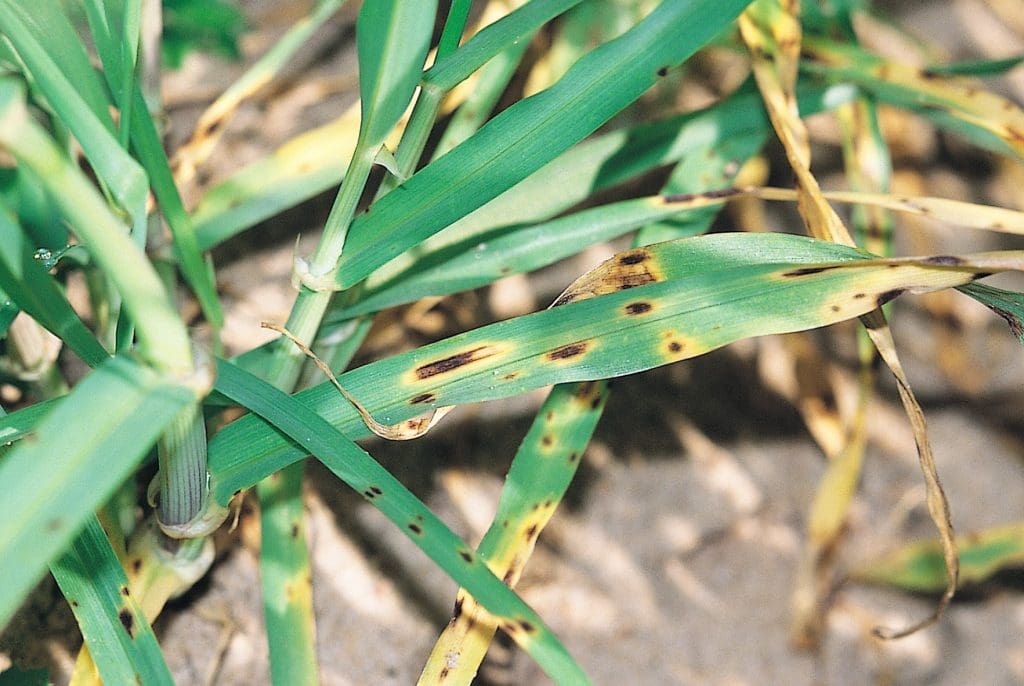
Growers are being advised to monitor crops for spot form of net blotch (SFNB). (Photo: Hugh Wallwork)
DESPITE the dry conditions, growers are being warned to check barley crops for disease following reports of spot form net blotch (SFNB) in Queensland and northern New South Wales this winter.
Prolonged dry weather has historically reduced disease pressure on crops, but pathologists have been fielding a number of calls this month regarding SFNB in barley crops in Central Queensland and the Bundaberg and western Darling Downs areas.
Reports of SFNB have also come in from the Croppa Creek region of northern NSW.
Queensland Department of Agriculture and Fisheries (QDAF) pathologist Lisle Snyman said the disease prevalence was unexpected given dry conditions but being moisture-stressed might have made some crops more vulnerable this season.
“While we are surprised to see the level and extent of disease given the dry, we also know SFNB tends to prevail in tough conditions where plants are moisture stressed, making them more pre-disposed to infection,” she said.
“While many of the reports coming in are from crops under irrigation, a few relate to dryland paddocks.
“We also have reports of late crops around Pittsworth showing signs of SFNB so in these cases growers would be well advised to start disease surveillance as these crops may be very susceptible when or if the season breaks in spring.”
Diseases such as SFNB are common in barley crops across Queensland and NSW.
Data from yield loss response curves trials indicated that losses could be up to 30 per cent in susceptible varieties, however, are more likely to be about 20pc even under favourable conditions.
Losses are influenced by varietal susceptibility, disease severity, duration of the epidemic and environmental conditions.
Dr Snyman said it was critical growers and agronomists checked crops for disease and evaluated the benefits of spending valuable dollars on fungicide treatments this season.
“Vigilant disease management is the key to reducing the impact of the disease and maximising the yield,” she said.
“However, assessing the yield potential of crops, or determining their potential end use this season, will really govern how and what growers should spend on fungicide treatments.”
Dr Snyman said growers would be advised to consider the withholding periods of fungicide treatments, particularly if crops were intended for stock consumption or forage.
Grains Research and Development Corporation (GRDC) crop protection manager – north, Vicki Green, said long-term-tactical approach to SFNB was important.
“In dry seasons there is generally lower disease pressure. So, when disease is present your decisions about fungicide application costs versus potential economic returns are not always straightforward,” she said.
“In comparison, when there is high disease pressure, usually from wet conditions early in the season, then a robust spray strategy can improve grain quality, yield and returns to the grower.”
Mrs Green said from a long-term perspective, crop rotations could also reduce inoculum levels and the build-up of early disease pressure.
“However, under the dry conditions inoculum isn’t breaking down and so we are seeing disease expression at times and in areas we typically wouldn’t expect,” she said.
“So, in tough seasons like the one being experienced in Queensland and New South Wales it is really a case of growers evaluating the benefits and costs of SFNB control.”
Control strategies
Research through the GRDC co-investment recommends that growers consider some of the following strategies to assist with SFNB control whilst limiting the risk of fungicide resistance development:
- Use resistant varieties. Losses >10pc are unlikely in varieties rated MS or better.
- Do not plant barley on barley – SFNB is stubble-borne.
- Choose fungicides with different modes of action (if available).
- Never apply the same Group 3 fungicide twice in a row.
- Apply fungicides from Groups 7 and 11 no more than once per season.
- Incorporate the use of seed dressing, in-furrow and foliar products containing fungicide mixtures from different chemical groups (such as 3 (DMI), 7 (SDHI) and 11 (Qol)).
- Avoid using tebuconazole as a stand-alone product in barley for any disease.
- Use other DMI-based mixtures (such as propiconazole, prothioconazole or epoxiconazole) only once, followed by mixtures containing another actives (preferably from the SDHI or QoI groups).
- If resistance is present, or suspected, avoid or minimise the use of that mode of action to reduce further selection for resistance.
- Do not exceed label rates.
Growers are encouraged to consider implementing across-season tactics to reduce the risk of net blotch outbreaks and resistance selection.
These include rotating crops or managing stubble to minimise disease carry-over and selecting more disease-resistant barley varieties to reduce potential disease severity.
Source: GRDC

HAVE YOUR SAY